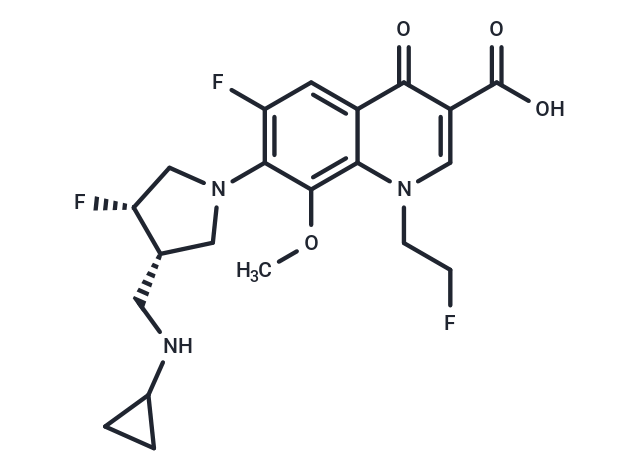Shopping Cart
- Remove All
 Your shopping cart is currently empty
Your shopping cart is currently empty

Lascufloxacin, a potent and orally active fluoroquinolone antibacterial agent, holds potential for the treatment of various infectious diseases, including lower respiratory tract infections. It effectively inhibits infections caused by a wide range of pathogens, encompassing those resistant to quinolones.

| Pack Size | Price | Availability | Quantity |
|---|---|---|---|
| 25 mg | $1,670 | 6-8 weeks | |
| 50 mg | $2,180 | 6-8 weeks | |
| 100 mg | $2,800 | 6-8 weeks |
| Description | Lascufloxacin, a potent and orally active fluoroquinolone antibacterial agent, holds potential for the treatment of various infectious diseases, including lower respiratory tract infections. It effectively inhibits infections caused by a wide range of pathogens, encompassing those resistant to quinolones. |
| In vitro | Lascufloxacin demonstrates pronounced efficacy against both Gram-positive and Gram-negative bacteria, including macrolide-resistant M. pneumoniae, with a minimum inhibitory concentration for 90% of organisms (MIC90) as low as 0.12 μg/mL. It exhibits a broad spectrum of activity, with MIC values ranging from 0.008 to 0.015 μg/mL for S. aureus strains and maintaining effectiveness against various S. aureus mutant strains at 2 μg/mL, albeit showing some level of incomplete cross-resistance. Its potency surpasses that of other quinolones against first- and second-step mutants of S. pneumoniae, with MIC values for double mutants between 0.25 and 0.5 μg/mL. In the realm of Gram-negative bacteria, Lascufloxacin is active against Moraxella catarrhalis and both ampicillin-susceptible and -resistant Haemophilus influenzae strains, maintaining an MIC90 of 0.06 μg/mL. Additionally, it exhibits notable MIC90 values against Enterobacter spp., Klebsiella pneumoniae, and Acinetobacter spp. at 0.25 μg/mL, 0.25 μg/mL, and 0.5 μg/mL respectively, and displays efficacy against E. coli and P. aeruginosa with MIC90s of 0.25 μg/mL and 4 μg/mL, respectively. The MIC50 and MIC90 values against M. pneumoniae are 0.12 μg/mL and 0.25 μg/mL, showcasing its significant antibacterial activity across a range of pathogens[1]. |
| In vivo | A pharmacodynamic study employing a mouse thigh infection model demonstrates that to achieve bacteriostasis, or a 1-log or 2-log reduction in S. pneumoniae colony-forming units (CFU), the necessary ratios of the free area under the concentration-time curve (fAUC) to the minimum inhibitory concentration (MIC) in plasma are 10, 16, and 28, respectively. Lascufloxacin effectively eliminates bacterial presence in this mouse model when the plasma concentration-time curve (AUC) is replicated with a daily dosage of 75 mg [q.d.]) [1]. |
| Alias | KRP-AM1977X |
| Molecular Weight | 439.43 |
| Formula | C21H24F3N3O4 |
| Cas No. | 848416-07-9 |
| Storage | Powder: -20°C for 3 years | In solvent: -80°C for 1 year | Shipping with blue ice. |

Copyright © 2015-2024 TargetMol Chemicals Inc. All Rights Reserved.